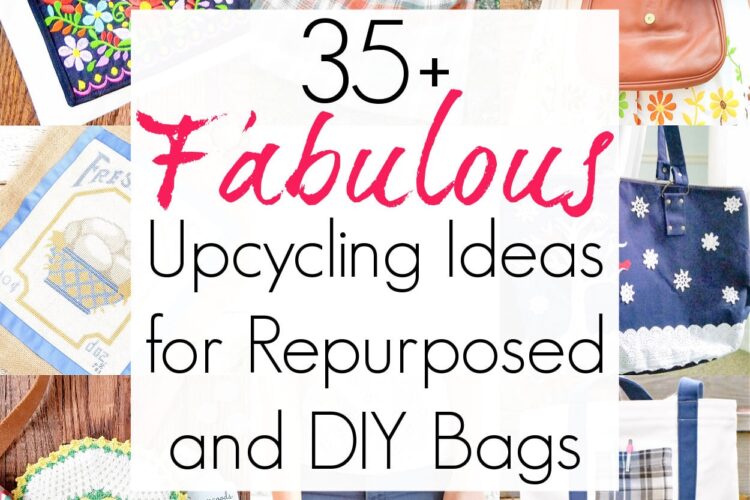
I. Introduction to Upcycled Bags: What They Are and Why They Matter
II. Materials and Tools Needed for Making Upcycled Bags
III. Step-by-Step Guide to Creating Your Own Upcycled Bag
Introduction to Upcycled Bags: What They Are and Why They Matter
Have you ever heard the term upcycled bags? If not, you’re in for a treat! Upcycled bags are more than just a trendy accessory; they represent a movement towards sustainability, creativity, and individuality. So, what exactly are they, and why should you care? Let’s dive in!
What Are Upcycled Bags?
Simply put, upcycled bags are made from materials that have been repurposed — think old jeans, discarded banners, or even leftover fabric scraps. Instead of ending up in a landfill, these items are transformed into stylish, functional bags, each with its own unique story. It’s like giving a second life to something that would otherwise be forgotten!
Why Do Upcycled Bags Matter?
You might wonder, “Why should I bother with upcycled bags?” Well, here are a few compelling reasons:
- Environmental Impact: The fashion industry is notorious for its contribution to waste and pollution. By choosing upcycled bags, you help reduce the demand for new materials, lowering your carbon footprint. It’s a small change that can lead to significant environmental benefits!
- Creativity at Its Finest: One of the most exciting aspects of upcycled bags is the creativity involved in making them. Each bag can be a unique piece of art, reflecting the maker’s personality and style. When you carry an upcycled bag, you’re not just carrying a bag; you’re showcasing a story and a set of values.
- Support Local Artisans: Many upcycled bags are crafted by local artisans or small businesses. By purchasing these bags, you’re not only getting a beautiful product but also supporting the local economy. It’s a win-win situation!
- Durability and Functionality: Contrary to what some may think, upcycled bags can be incredibly durable. Many of the materials used, like canvas from old tents or sturdy denim, are designed to withstand wear and tear, making these bags not only fashionable but functional as well.
Making a Statement
Carrying an upcycled bag sends a bold message: you care about the planet and are willing to take steps towards sustainability. In a world where fast fashion is so prevalent, choosing upcycled products is a statement of your values. It sparks conversations and inspires others to think about their consumption habits. Plus, it feels good to know that you’re making a difference!
The Joy of Personalization
Another fantastic aspect of upcycled bags is the opportunity for personalization. Because they are often crafted from various materials, you can find or create a bag that truly reflects your style. Whether it’s a bright, patchwork tote or a sleek, minimalist crossbody, the options are endless. You can even get involved in the making process yourself!
In conclusion, upcycled bags are more than just a trend; they represent a way to live consciously and creatively. By choosing these bags, you’re joining a community of like-minded individuals who prioritize sustainability and individuality. So, why not take the plunge and explore the world of upcycled bags? You might just find your new favorite accessory!
Materials and Tools Needed for Making Upcycled Bags
So, you’ve decided to dive into the wonderful world of upcycled bags? Great choice! Not only are these bags stylish and unique, but they also help reduce waste and give new life to materials that might otherwise go to the landfill. Before you roll up your sleeves and get started, let’s talk about what you’ll need to gather to make your crafting experience smooth and enjoyable.
Essential Materials
First things first—let’s look at the materials you’ll want to have on hand. You might already have some of these items lying around your home, waiting for a second chance:
- Old Clothes: T-shirts, jeans, or even a favorite but worn-out jacket can make excellent bag material. The best part? You can pick fabrics that suit your personal style!
- Textile Scraps: If you have remnants from previous sewing projects, now’s the time to put them to use. Look for sturdy fabrics like canvas or denim.
- Linings: To add a bit of flair and durability, consider repurposing old curtains, tablecloths, or other fabric remnants as linings.
- Interfacing: This optional material can add structure to your bag, making it sturdier. Check craft stores for fusible interfacing that can be easily applied.
Tools You’ll Need
No crafting venture is complete without the right tools. Here’s a handy list of what you’ll need to make your upcycled bag:
- Fabric Scissors: A good pair of fabric scissors will make cutting through thick materials a breeze.
- Sewing Machine: While you can stitch by hand if you’re feeling adventurous, a sewing machine will save you time and effort. Make sure you have a needle that can handle thicker fabrics.
- Thread: Choose a thread that matches the fabric you’re working with. You might want to get a few different colors to add some creativity to your designs.
- Measuring Tape: Accurate measurements are key to ensuring your bag turns out just right.
- Chalk or Fabric Marker: Use chalk or a fabric marker to mark your cutting lines. It washes out easily, so don’t worry about making mistakes!
- Pins or Clips: These will help you hold your fabric pieces together as you sew, ensuring everything stays in place.
Optional Accessories
Want to add a personal touch or some extra functionality to your bag? Here are a few optional accessories you might consider:
- Straps or Handles: You can repurpose existing straps or make your own from fabric or webbing.
- Buttons, Zippers, and Velcro: These can add both style and practicality to your bag. Dig through your old clothing or craft stash to find the perfect additions.
- Decorative Elements: Think about adding patches, embroidery, or fabric paint to really make your upcycled bag stand out!
With these materials and tools in your arsenal, you’re all set to embark on your upcycling journey. Remember, the beauty of creating your own bag lies in the uniqueness of the materials you choose and the creativity you bring to the project. Happy crafting!
Step-by-Step Guide to Creating Your Own Upcycled Bag
Creating your very own upcycled bag can be a fun and fulfilling project! Not only do you get to express your creativity, but you also contribute to reducing waste. So, let’s dive into the process of transforming old materials into a stylish and functional bag!
Gather Your Materials
Before you start crafting, let’s make sure you have everything you need. Here’s a quick list of what to gather:
- Old clothing or fabric scraps (like jeans, t-shirts, or tablecloths)
- Scissors
- Sewing machine (or needle and thread if you prefer hand sewing)
- Measuring tape
- Chalk or fabric marker for marking
- Pins or clips to hold fabric pieces together
- A sturdy strap (you can repurpose an old belt or use fabric)
Choose Your Design
Next, it’s time to decide what kind of bag you want to create. Do you envision a tote, a backpack, or maybe a small crossbody? Sketch out your idea or find inspiration online. Remember, the beauty of upcycling is that it doesn’t have to be perfect—it just has to be you!
Measure and Cut Your Fabric
With your design in mind, it’s time to measure and cut your fabric. Here’s how to do it:
- Measure the dimensions you want for your bag. A simple tote might be around 15 inches wide by 15 inches tall.
- Mark your measurements on the fabric with chalk or a fabric marker.
- Carefully cut out your fabric pieces. You’ll typically need two pieces for the bag itself and two for the lining.
Sew the Main Body of the Bag
Now comes the fun part—putting it all together! Follow these steps:
- Place the two outer pieces of fabric right sides together, and pin or clip them to hold in place.
- Sew along the sides and bottom, leaving the top open. Remember to backstitch at the beginning and end for durability!
- Repeat this with the lining fabric.
Add the Strap
Once you have your main body sewn, it’s time to attach the strap:
- Turn the outer bag right side out and tuck the lining inside.
- Pin the strap to the sides of the bag, making sure it’s securely attached.
- Sew the strap in place, reinforcing the stitches for added strength.
Finishing Touches
Finally, let’s put the finishing touches on your new bag:
- Check for any loose threads and trim them off.
- Turn the bag right side out and give it a good shake to smooth out any wrinkles.
- Admire your creation! You’ve just made something unique and eco-friendly.
And there you have it! Your very own upcycled bag that not only looks good but also does good for the environment. Enjoy carrying your sustainable style wherever you go!










Comments